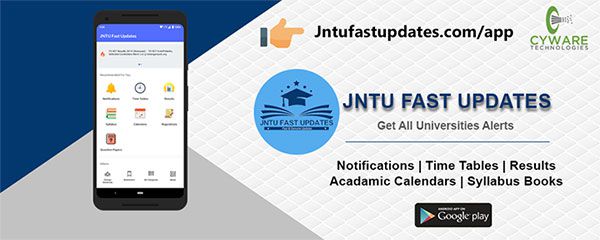JNTUK R20 2-2 Induction and Synchronous Machines Material PDF Download
Students those who are studying JNTUK R20 EEE Branch, Can Download Unit wise R20 2-2 Induction and Synchronous Machines (ISM) Material/Notes PDFs below.

JNTUK R20 2-2 Induction and Synchronous Machines Material PDF Download
Preamble: This course covers the topics on 3-phase induction motor, 1-phase induction motor and synchronous machines which have wide application in power systems. The main aim of the course is to provide a detailed analysis of operation and performance of 3-phase induction motor, 1-phase induction motor and synchronous machines. In addition, it also covers voltage regulation and parallel operation of synchronous generators.
Course Objectives:
- Understand the principle of operation and performance of 3-phase induction motor.
- Quantify the performance of induction motor and induction generator in terms of torque and slip.
- To understand the torque producing mechanism of a single phase induction motor.
- To understand the principle of emf generation, the effect of armature reaction and predetermination of voltage regulation in synchronous generators.
- To study parallel operation and control of real and reactive powers for synchronous generators.
- To understand the operation, performance and starting methods of synchronous motors.
UNIT-1
3-phase induction motors Construction details of squirrel cage and slip ring induction motors – production of rotating magnetic field – principle of operation – Equivalent circuit –phasor diagram- slip speed-rotor emf and rotor frequency – rotor current and pf at standstill and during running conditions – rotor power input, rotor copper loss and mechanical power developed and their interrelationship.
Download UNIT-1 Material PDF | Reference-2
UNIT-2
Characteristics and testing methods of induction motors Torque equation – expressions for maximum torque and starting torque – torque slip characteristic – double cage and deep bar rotors – crawling and cogging – speed control of induction motor with V/f control method – no load and blocked rotor tests – circle diagram for predetermination of performance – induction generator operation (Qualitative treatment only)
UNIT-3
Starting methods of 3-phase induction motors Methods of starting of three phase Induction motors: DOL, Auto transformer, Star-Delta and rotor resistance methods.
Single phase induction motors: Constructional features- equivalent circuit- problem of starting-double revolving field theoryMethods of starting. AC series motors.
Download UNIT-3 Material PDF | Reference-2
UNIT-4
Construction, operation, voltage regulation and parallel operation of synchronous generator: Constructional features of non-salient and salient pole machines –types of armature windings – distribution, pitch and winding factors – E.M.F equation –improvements of waveform and armature reaction –phasor diagrams- voltage regulation by synchronous impedance method – MMF method and Potier triangle method– two reaction analysis of salient pole machines and phasor diagram.
Parallel operation with infinite bus and other alternators – synchronizing power – load sharing – control of real and reactive power – numerical problems.
Download UNIT-4 Material PDF | Reference-2
UNIT-5
Synchronous motor – operation, starting and performance Synchronous motor principle and theory of operation – phasor diagram – starting torque – variation of current and power factor with excitation – capability curves – synchronous condenser – mathematical analysis for power developed – hunting and its suppression – methods of starting – applications.
Download UNIT-5 Material PDF | Reference-2
Text Books:
1. Electrical Machines by P.S. Bhimbra, Khanna Publishers
2. Electric Machinery by A.E.Fitzgerald, Charles Kingsley, Stephen D.Umans, TMH
Reference Books:
1. Performance and design of AC machines – M.G. Say
2. Alternating Current Machines by A.F.Puchstein, T.C. Lloyd, A.G. Conrad, ASIA Publishing House
3. Electrical Machinery Fundamentals by Stephen J Chapman McGraw Hill education, 2010.
4. Electrical Machines by R.K.Rajput, Lakshmi publications, 5th edition
Course Outcomes:
- Explain the operation and performance of three phase induction motor.
- Analyze the torque-speed relation, performance of induction motor and induction generator.
- Implement the starting of single phase induction motors.
- Develop winding design and predetermine the regulation of synchronous generators.
- Explain hunting phenomenon, implement methods of staring and correction of power factor with synchronous motor.


320-x100(1).gif)
